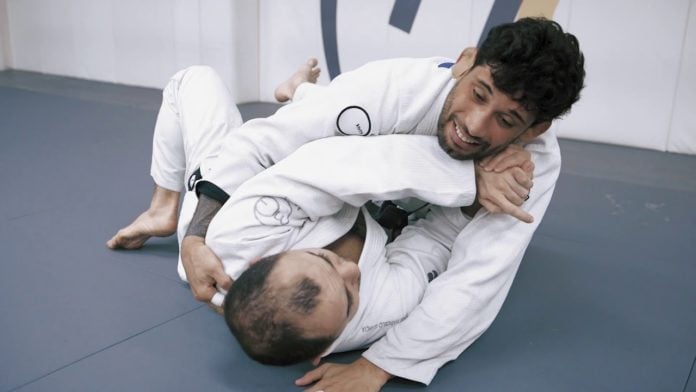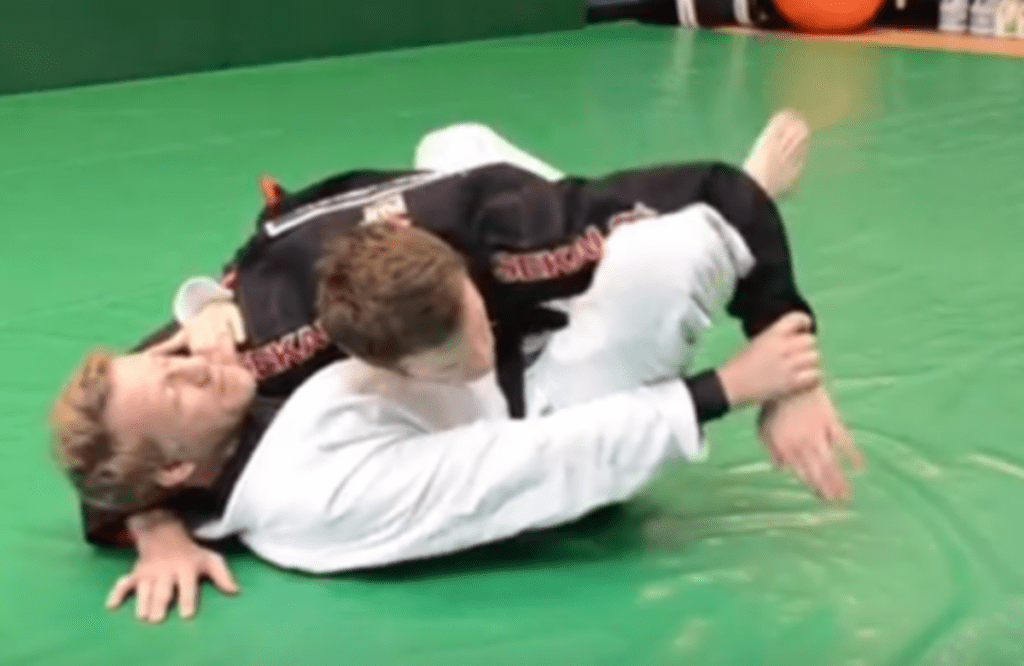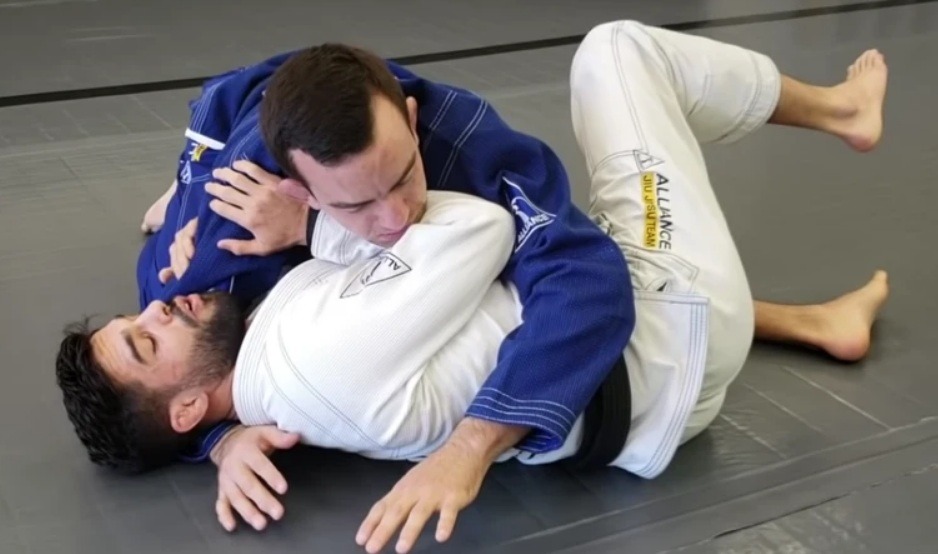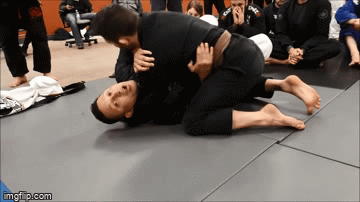
What do you do when you get caught in a bad so in Brazilian Jiu-Jitsu? As far as I can see, you either stay there and let the other person submit or advance, start jumping and flopping around like a fish out of water, or you get out of there. The final option seems like the best option if you ask me, and I am sure most of you agree. However, there’s one better. Why just escape, when you can actually attack instead? Escaping side control with the help of a very sneaky armlock is a great example of this concept.
How do you get out of side control? The correct answer is – hard. If the top person knows what they’re doing, you’ll be stuck in between different side control variations until they see fit to submit you or go to the next checkpoint which is knee on belly, mount, or back control (in most cases). Unless you have a few tricks up your sleeve which will make escaping side control seem easy and effortless. And since you’re doing tricks, why not throw in a submission threat along the way?
Escaping Vs. Countering Bad Positions
As a small grappler (size, not age) I often had to figure out ways to get out of tight spots in manners that are not considered usual per see. There are plenty of different options out there and the realm of escapes is a huge and extremely interesting one. However, what I quickly learned while being crushed by people quite a lot bigger and stronger than me was that it is the mindset that mattes most when you’re in a tight spot (pun intended) in BJJ.

Escaping bad spots like side control should become fun. Yeah, you read that right. When you embrace the suffering and pressure and stop sweating the fact that someone got a better position than you, you’ll suddenly start seeing escaping options everywhere. Not just that but you’ll start seeing intricate ways in which you can counter the position completely forcing people to get up off of you on their own, under the threat of submissions. Or, better yet, you’ll actually get the tap from there.
The Challenges Of Escaping Side Control
Before I give you a simple way of escaping side control into an armlock, let’s see the few challenges you’ll surely encounter against an experienced top player. First up, weight distribution. It is not just the fact that someone is going to be heavy on top of you. They will also know where to project at pressure for maximum efficiency i.e. your chest, neck, jaw, etc.
Moreover, experienced grapplers will try and keep your body divided in order to prevent it from working together for an escape. That means that you’ll either end up with pinned head and shoulders, or hips. Even more so, they’ll try to pin arms to the ground, or cradle your legs in order to further twist you up into accepting defeat.

Finally, there’s gravity. When you’re on the bottom it is working against you, keeping the top person on top, and preventing you from sneaking away, regardless of your method of escape. If you anticipate all these challenges, you’ll find it very easy to deal with anyone and escape side control without much effort.
A Sneaky Armlock To The Rescue
Escaping side control starts with your arms in a way that an opponent can’t isolate them over your head or pin them on the ground to your sides. In other words, you keep them tight to your body, in a frame structure. Try and keep your elbows to your ribs and you’ll be safe enough to start looking for escapes, or better yet, counters.
With the arms in place, you will make space by bridging, and looking to hip escape, However, and an experienced opponent will let you bridge but will follow you when you hip escape, most likely transitioning into another version of side control to keep you there. That’s where sneakiness and countering come in. Instead of thinking escape, you’ll think armlock

If the opponent heads into you looking to transition, you’ll be waiting for them with a straight armlock. Simply extending your spine will get your grip down to their elbow, and their wrist on your shoulder where you can trap it with your head. Boom, you get a tap.
If the opponent decides to back away afraid of the submission, you’re now in guard, without having to hip escape, drag across the floor and attempt o keep your frames in as an opponent transitions to kill your escapes.
In Summary
Escaping side control doesn’t have to be difficult and excruciating, In fact, you don’t need to escape it at all. What if you could force an opponent off you by threatening to tap them out? This easy and sneaky armlock only requires you to slightly bridge so that you get the grips and the knee in. Form here on, you’re asking for their money or their life, and whatever the choice, you’ll emerge the winner.


![Darce Choke Encyclopedia – Origins, Mechanics and Variations [2025] BJJ, choke, Brabo, BJJ Darce Choke, D'arce Choke, Darce BJJ Choke](https://bjj-world.com/wp-content/uploads/2017/11/JungPoirierLeeYahoo-218x150.jpg)









![Get Off My Legs Gringo Craig Jones DVD Review [2025] Get Off My Legs Gringo Craig Jones DVD Review](https://bjj-world.com/wp-content/uploads/2025/03/get-off-my-legs-gringo-craig-jones-dvd-review-218x150.png)

![Leg Lock Entries Helena Crevar DVD Review [2025] Leg Lock Entries Helena Crevar DVD Review](https://bjj-world.com/wp-content/uploads/2025/03/leg-lock-entries-helena-crevar-dvd-review-218x150.png)
![Special K Guard Neil Melanson DVD Review [2025] Special K Guard Neil Melanson DVD Review](https://bjj-world.com/wp-content/uploads/2025/03/special-k-guard-neil-melanson-dvd-review-218x150.png)
![Arm Bar It All Shawn Melanson DVD Review [2025] Arm Bar It All Shawn Melanson DVD Review](https://bjj-world.com/wp-content/uploads/2025/03/arm-bar-it-all-shawn-melanson-dvd-review-218x150.png)














![Basic Closed Guard Jasmine Rocha DVD Review [2024] Basic Closed Guard Jasmine Rocha DVD Review](https://bjj-world.com/wp-content/uploads/2024/11/basic-closed-guard-jasmine-rocha-dvd-review-100x70.png)
![Jett Thompson Master Ankle and Aoki Lock DVD Review [2024] Jett Thompson Master Ankle and Aoki Lock DVD Review](https://bjj-world.com/wp-content/uploads/2024/09/jett-thompson-master-ankle-and-aoki-lock-dvd-review-100x70.png)

![The Whole Omoplata Enchilada Lyanne Perez DVD Review [2024] The Whole Omoplata Enchilada Lyanne Perez DVD Review](https://bjj-world.com/wp-content/uploads/2024/11/whole-omoplata-enchilada-lyanne-perez-dvd-review-100x70.png)
![Slip N Slide Into Victory Julián Espinosa DVD Review [2025] Slip N Slide Into Victory Julián Espinosa DVD Review](https://bjj-world.com/wp-content/uploads/2025/01/slip-n-slide-into-victory-julian-espinosa-dvd-review-100x70.png)

![Ginastica Natural Alvaro Romano DVD Review [2024] Ginastica Natural Alvaro Romano DVD Review](https://bjj-world.com/wp-content/uploads/2024/12/ginastica-natural-alvaro-romano-dvd-review-100x70.png)



![Foot Sweep the World Dainis Nguyen-Huu DVD Review [2024] Foot Sweep the World Dainis Nguyen-Huu DVD Review](https://bjj-world.com/wp-content/uploads/2024/11/foot-sweep-the-world-dainis-nguyen-huu-dvd-review-100x70.png)
![Zen Guide To Submission Grappling Margot Ciccarelli DVD Review [2025] Zen Guide To Submission Grappling Margot Ciccarelli DVD Review](https://bjj-world.com/wp-content/uploads/2025/02/submission-grappling-margot-ciccarelli-dvd-preview-100x70.png)
![Arm Bar It All Shawn Melanson DVD Review [2025] Arm Bar It All Shawn Melanson DVD Review](https://bjj-world.com/wp-content/uploads/2025/03/arm-bar-it-all-shawn-melanson-dvd-review-100x70.png)

![Welcome To The Darce Side Travis Moore DVD Review [2025] Welcome To The Darce Side Travis Moore DVD Review](https://bjj-world.com/wp-content/uploads/2025/01/welcome-to-the-darce-side-travis-moore-dvd-review-100x70.png)

